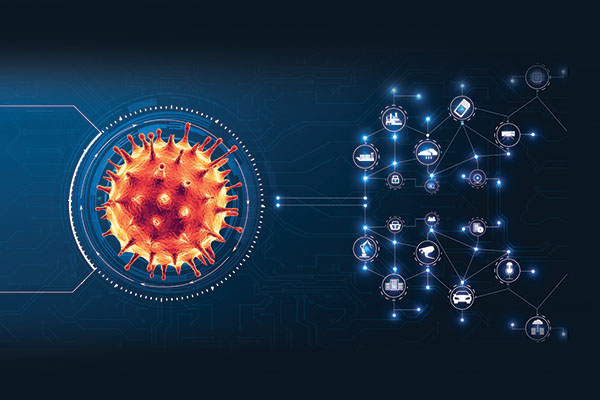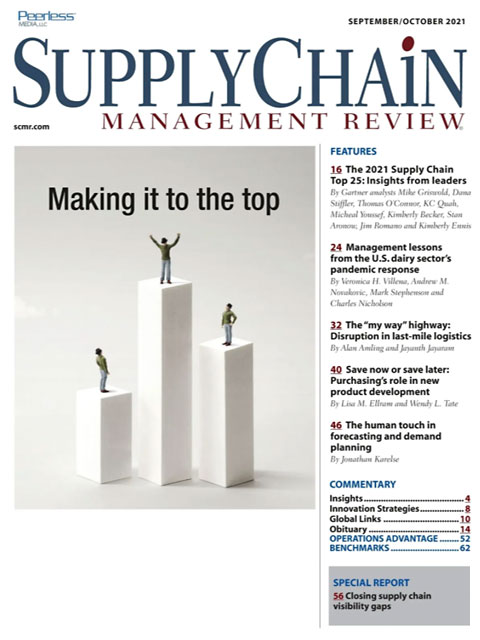Sorry, but your login has failed. Please recheck your login information and resubmit. If your subscription has expired, renew here.
September-October 2021
This time every year, we publish Gartner’s Top 25 supply chains, the annual list of the supply chains that have made it to the top, a list that now also includes 5 Masters, or companies that have consistently outperformed year after year. You can read the article in this issue, along with the web exclusive material we publish on scmr.com, to find out what it takes to become a supply chain leader. Browse this issue archive.Need Help? Contact customer service 847-559-7581 More options
Digital transformation in organizations is well underway as companies embrace connected “ecosystem commerce” and leverage Business 4.0 technologies. While the COVID-19 pandemic brought a pause in the progress, it also altered the way organizations will approach the new normal—emphasizing the absolute requirement to adapt quickly, plan on the go and execute from anywhere. It has also hastened the need for organizations to transform, and in some cases reinvent, themselves.
New normal or new beginning
As the world contemplates a new, post-pandemic beginning, organizations are re-evaluating priorities and charting the way forward. To begin with, companies must invest in unlearning the supply chain operating strategies they have relied on for years and learn how emerging ecosystem business models will redefine the supply network landscape. They need to consider which ecosystem commerce strategies and technology infrastructure will be required to compete in the post pandemic environment. Simultaneously, companies will have to deal with the uncertainty and volatility that persists. Companies are seeking to improve their supply chain resilience with flexibility and responsiveness.
For example, sourcing and manufacturing from China used to be the bedrock of global trade. Considering the various geo-political and economic issues, many organizations are now exploring alternatives to reduce their reliance on China and evaluating multiple sourcing and supply network strategies before embarking on the transformation.
A fork in the road?
While undergoing transformation, companies have typically split the process into two programs—first, by defining strategy and, second, by working with multiple systems integrators on various implementation aspects often without clear strategic alignment amongst them. As a result, gaps often crop up between the strategy and the solution integration necessitating changes to the plan. Ensuring that a transformation program office that aligns strategy with infrastructure and implementation is in place throughout the transformation reduces the risk that the transformation can move off course.

This complete article is available to subscribers only.
Log in now for full access or start your PLUS+ subscription for instant access.
SC
MR
Sorry, but your login has failed. Please recheck your login information and resubmit. If your subscription has expired, renew here.
September-October 2021
This time every year, we publish Gartner’s Top 25 supply chains, the annual list of the supply chains that have made it to the top, a list that now also includes 5 Masters, or companies that have consistently… Browse this issue archive. Access your online digital edition. Download a PDF file of the September-October 2021 issue.Digital transformation in organizations is well underway as companies embrace connected “ecosystem commerce” and leverage Business 4.0 technologies. While the COVID-19 pandemic brought a pause in the progress, it also altered the way organizations will approach the new normal—emphasizing the absolute requirement to adapt quickly, plan on the go and execute from anywhere. It has also hastened the need for organizations to transform, and in some cases reinvent, themselves.
New normal or new beginning
As the world contemplates a new, post-pandemic beginning, organizations are re-evaluating priorities and charting the way forward. To begin with, companies must invest in unlearning the supply chain operating strategies they have relied on for years and learn how emerging ecosystem business models will redefine the supply network landscape. They need to consider which ecosystem commerce strategies and technology infrastructure will be required to compete in the post pandemic environment. Simultaneously, companies will have to deal with the uncertainty and volatility that persists. Companies are seeking to improve their supply chain resilience with flexibility and responsiveness.
For example, sourcing and manufacturing from China used to be the bedrock of global trade. Considering the various geo-political and economic issues, many organizations are now exploring alternatives to reduce their reliance on China and evaluating multiple sourcing and supply network strategies before embarking on the transformation.
A fork in the road?
While undergoing transformation, companies have typically split the process into two programs—first, by defining strategy and, second, by working with multiple systems integrators on various implementation aspects often without clear strategic alignment amongst them. As a result, gaps often crop up between the strategy and the solution integration necessitating changes to the plan. Ensuring that a transformation program office that aligns strategy with infrastructure and implementation is in place throughout the transformation reduces the risk that the transformation can move off course.
SC
MR


Latest Supply Chain News
- Planning fatigue may be settling in
- Inflation, economic worries among top supply chain concerns for SMBs
- April Services PMI declines following 15 months of growth, reports ISM
- Attacking stubborn COGS inflation with Digital Design-and-Source-to-Value
- Despite American political environment, global geopolitical risks may be easing
- More News
Latest Podcast

 Explore
Explore
Business Management News
- Planning fatigue may be settling in
- Inflation, economic worries among top supply chain concerns for SMBs
- April Services PMI declines following 15 months of growth, reports ISM
- Attacking stubborn COGS inflation with Digital Design-and-Source-to-Value
- Joseph Esteves named CEO of SGS Maine Pointe
- Employees, employers hold divergent views on upskilling the workforce
- More Business Management
Latest Business Management Resources

Subscribe

Supply Chain Management Review delivers the best industry content.

Editors’ Picks






